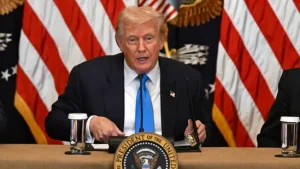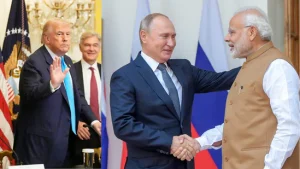Washington D.C. – The latest US India Trade War Update reveals a dramatic escalation as President Donald Trump announced he would raise tariffs on India “very substantially over the next 24 hours.” This development marks a significant intensification of trade tensions between the two nations, with Trump specifically citing India’s continued purchase of Russian oil as the primary justification for enhanced economic sanctions.
In a Tuesday interview, Trump emphasized that while India has offered the United States “zero tariffs” under a potential trade deal, this concession would not be sufficient due to New Delhi’s energy relationship with Moscow. This US India Trade War Update demonstrates how geopolitical considerations are increasingly influencing bilateral economic relationships.
The President’s latest statement represents the sharpest escalation since announcing a 25 percent tariff on Indian goods effective August 7, along with unspecified penalties for India’s defense and energy imports from Russia. This US India Trade War Update signals a comprehensive approach to economic pressure targeting multiple sectors of Indo-US commerce.
Trump’s Accusations Against India’s Trading Practices

The current US India Trade War Update centers on Trump’s characterization of India as an unfair trading partner. Speaking to reporters, Trump stated: “With India, what people don’t like to say about India, they’re the highest tariff nation. They have the highest tariff of anybody. We do very, very little business with India because their tariffs are so high.”
Trump further elaborated on his concerns, declaring: “India has not been a good trading partner, because they do a lot of business with us, but we don’t do business with them. So we settled on 25% tariff, but I think I’m going to raise that very substantially over the next 24 hours, because they’re buying Russian oil. They’re fueling the war machine.”
This US India Trade War Update reveals the President’s frustration with what he perceives as asymmetrical trade relationships, where American markets remain more accessible to Indian goods than vice versa.
Russia’s Defense of Sovereign Trading Rights


The US India Trade War Update has prompted strong reactions from Moscow, with Kremlin spokesman Dmitry Peskov defending countries’ rights to choose their trading partners independently. Peskov told journalists: “We believe that sovereign countries must have, and do have, the right to choose their trade partners, the partners in trade and economic cooperation, on their own, and independently determine those modes of trade and economic cooperation that suit the interests of a country in question.”
Also Read: Shocking New US Visa Rule Requires $15,000 Bond for Tourist and Business Visas
This Russian response to the US India Trade War Update highlights the broader geopolitical implications of US economic pressure tactics. Russian Foreign Ministry Spokesperson Maria Zakharova accused the US administration of pursuing neocolonial policies against Global South nations to maintain American hegemony.
“Washington cannot come to terms with the loss of hegemony in the emerging multipolar world order and continues to pursue a neocolonial policy in an attempt to maintain its position, using politicised levers of economic pressure against those who refuse to follow in its wake in the international arena,” Zakharova stated.
India’s Strong Counter-Response and Economic Defense
The US India Trade War Update includes New Delhi’s forceful rejection of American pressure tactics. India’s Ministry of External Affairs called the targeting of India “unjustified and unreasonable,” stating that the country would take “all necessary measures” to safeguard its “national interests and economic security.”
India’s response to this US India Trade War Update included pointing out American hypocrisy regarding Russian trade. The MEA highlighted that “the US continues to import from Russia uranium hexafluoride for its nuclear industry, palladium for its EV industry, fertilisers as well as chemicals.”
This defensive strategy demonstrates India’s determination to resist American economic coercion while highlighting inconsistencies in US policy regarding Russian trade relationships.
Economic Impact Assessment and Sectoral Analysis
The US India Trade War Update has prompted immediate economic analysis from rating agencies. ICRA revised India’s FY26 GDP growth forecast downward from 6.2 percent to 6.0 percent, citing US tariffs and uncertainty around potential penalties as key risks.
Despite India’s robust trade surplus with the US, which rose to $41 billion in FY2025 from $21 billion in FY2015, this US India Trade War Update threatens to erode India’s competitive advantages. ICRA identified textiles, auto components, tires, chemicals, agrochemicals, and cut & polished diamonds as the worst-hit sectors.
However, the US India Trade War Update analysis shows that pharmaceuticals, petroleum products, and telecom instruments remain relatively stable. The pharmaceutical sector, with 37 percent of its exports directed to the US, has been exempted from new tariffs so far.
Strategic Implications and Future Outlook
The current US India Trade War Update reveals signs of export re-routing as Indian businesses seek to maintain US market access. Diamond exporters may shift operations to Belgium and UAE, while automotive and tire manufacturers attempt to diversify into EU, UK, and Asia-Pacific markets.
This US India Trade War Update highlights the risk of trade diversion to countries like Vietnam and Indonesia, given their lower tariff burdens and increasing share in US imports. Unless bilateral trade agreements are concluded swiftly, the current tariff structure could significantly alter India’s export trajectory in FY2026 and beyond, according to economic analysts examining this developing US India Trade War Update.


